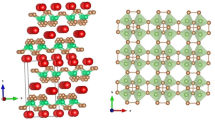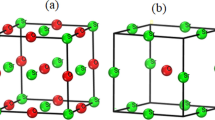Abstract
The effects of substitutional Mo and Cr in β-phase VH0.5 and V1−xMxH0.5625 (M = Mo, Cr; x = 0, 0.0625, 0.125) on the site occupation and diffusion paths of hydrogen are investigated by quantum mechanical calculations based on density functional theory. Fundamental processes of the interstitial-assisted mechanisms are systematically figured out, and specific values of the site energies are obtained with zero-point energy (ZPE) corrections. Hydrogen atoms are found to occupy the octahedral (O) interstitial sites in β-phase (V + M)H0.5 in the ground state. Upon increasing the hydrogen concentration H/(V + M) higher than 0.5, the additional H atom prefers to reside at the tetrahedral (T) interstitial sites. The minimum energy paths of hydrogen diffusion are analyzed by the Nudged Elastic Band method with ZPE corrections. The site occupation energy and activation energy for each hydrogen diffusion path are found to be strongly influenced by the substitution of Mo or Cr into vanadium hydride. The results presented in this work indicate that the additional H prefers to migrate directly from T site to the nearest neighboring T site without crossing O site. The energy barriers in the order of 0.253–0.276 eV of hydrogen migration in the V1−xMxH0.5625 hydrides obtained from ab initio simulations are in good agreement with the experimental data by means of 1H NMR measurement.




Similar content being viewed by others
References
Rosi NL, Eckert J, Eddaoudi M, Vodak DT, Kim J, O’Keeffe M, Yaghi OM (2003) Science 300:1127
Sakintunaa B, Darkrimb FL, Hirscherc M (2007) Int J Hydrogen Energy 32:1121
Schlapbach L, Züttel A (2001) Nature 414:353
Hauck J, Schenk HJ (1977) J. Less-Common Metals 51:251
Schober T, Wenzl H (1978) In: Alefeld G, Volkl J (eds) Hydrogen in metals II, topics in applied physics: application-oriented properties, vol 29. Springer, Berlin
Matsunaga T, Kon M, Washio K, Shinozawa T, Ishikiriyama M (2009) Int J Hydrogen Energy 34:1458
Fukai Y (2005) The metal-hydrogen system. Springer, Berlin
Akiba E, Iba H (1998) Intermetallics 6:461
Kubo K, Itoh H, Takahashi T, Ebisawa T, Kabutomori T, Nakamura Y, Akiba E (2003) J Alloys Compd 452:356
Shibuya M, Nakamura J, Enoki H, Akiba E (2009) J Alloys Compd 475:543–545
Tominaga Y, Nishimura S, Amemiya T, Fuda T, Tamura T, Kuriiwa T, Kamegawa A, Okada M (1999) Mater Trans, JIM 40(9):871
Kuriiwa T, Tamura T, Amemiya T, Fuda T, Kamegawa A, Takamura H, Okada M (1999) J Alloys Compd 433:293
Tamura T, Kamegawa A, Takamura H, Okada M (1862) Mater Trans 2001:42
Tamura T, Kazumi T, Kamegawa A, Takamura H, Okada M (2002) Mater Trans 42:2753
Asano K, Hayashi S, Nakamura Y, Akiba E (2010) J Alloys Compd 507:399
Asano K, Hayashi S, Nakamura Y, Akiba E (2012) J Alloys Compd 524:63
Johansson R, Ahuja R, Eriksson O, Hjorvarsson B, Scheicher RH (2015) Sci Rep 5:10301
Kim J, Yoo J-H, Cho S-W (2014) Mater Chem Phys 48:533
Schulz R, Boily S, Zaluski L, Zaluka A, Tessier P, Strom-Olsen JO (1995) Innov Metal Mater 63:529
Mananes A, Duque F, Mendez F, Lopez MJ, Alonso JA (2003) J Chem Phys 119:5128
Yarovskya I, Goldbergb A (2005) Mol Simul 31:475
Masuda J, Hashizume K, Otsuka T, Tanabe T, Hatano Y, Nakamura Y, Nagasaka T, Muroga T (2007) J Nucl Mater 1256:363
Hohenberg P, Kohn W (1964) Phys Rev 136:B864
Kohn W, Sham LJ (1965) Phys Rev 140:A1133
Kresse G, Hafner J (1993) Phys Rev B 47:558
Kresse G, Joubert D (1999) Phys Rev 59:1758
Kresse G, Hafner J (1994) Phys Rev B 49:14251
Kresse G, Furthmller J (1996) Comput Mater Sci 6:15
Vanderbilt D (1990) Phys Rev B 41:7892
Monkhorst HJ, Pack JD (1976) Phys Rev B 13:5188
Methfessel M, Paxton AT (1989) Phys Rev B 40:3616
Henkelman G, Uberuaga BP, Jonsson H (2000) J Chem Phys 113:9901
Henkelman G, Arnaldsson A, Jónsson H (2006) Comput Mater Sci 36:254
Sanville E, Kenny SD, Smith SD, Henkelman G (2007) J Comput Chem 28:899
Tang W, Sanville E, Henkelman G (2009) J Phys: Condens Matter 21:084204
Noda Y, Masumoto K, Koike S, Suzuki T, Sato S (1986) Acta Cryst B42:529
Kajitani T, Hirabayashi M (1985) Zeitschrift fur Physikalische Chemie Neue Folge, Bd 145:S27
Ogawa H (2013) J Alloys Compd 580:S131
Acknowledgements
The authors are thankful to the project on the establishment of Master’s in Nanotechnology program of Vietnam Japan University for providing the facilities. This work was supported in part by a grant for research from Vietnam National University, Hanoi (VNU) under project number QG.15.09.
Author information
Authors and Affiliations
Corresponding author
Ethics declarations
Conflict of interest
The authors declare that they have no conflict of interests.
Additional information
Publisher's Note
Springer Nature remains neutral with regard to jurisdictional claims in published maps and institutional affiliations.
Electronic supplementary material
Below is the link to the electronic supplementary material.
Rights and permissions
About this article
Cite this article
Phung, T.V.B., Ogawa, H., Dinh, V.A. et al. Effects of substitutional Mo and Cr on site occupation and diffusion of hydrogen in the β-phase vanadium hydride by first principles calculations. Theor Chem Acc 138, 16 (2019). https://doi.org/10.1007/s00214-018-2405-y
Received:
Accepted:
Published:
DOI: https://doi.org/10.1007/s00214-018-2405-y




